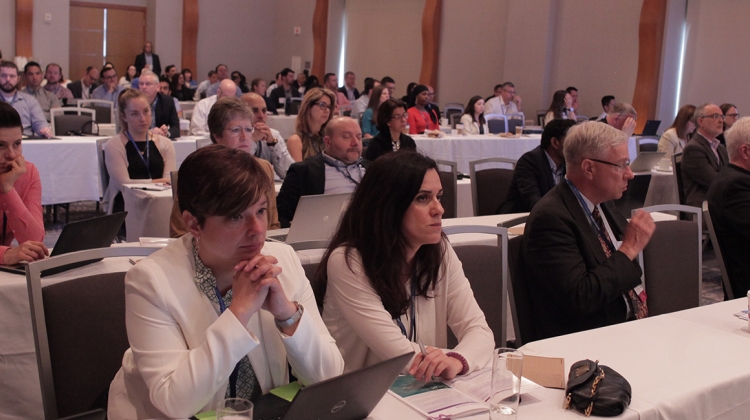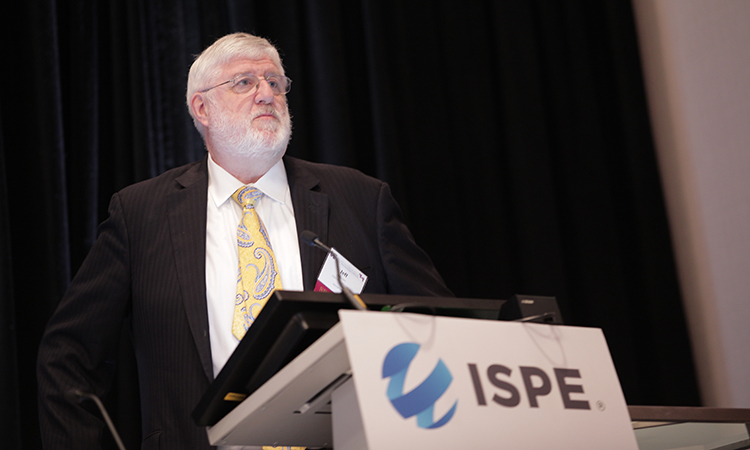Biopharma ‘Revolution’ in Boston: Day 2

What is coming next in biopharmaceutical manufacturing? That question was addressed in plenary sessions at the 2019 ISPE Biopharmaceutical Manufacturing Conference 18-20 June in Boston on the second and third days of the conference. View more about the opening day plenaries and the conference:
Riding the Next Wave
In the Wednesday 19 June plenary session “The Next Wave of Biologic Therapies,” Jeffrey Baker, PhD, deputy director, Office of Biotechnology Products, CDER, spoke to the impact of innovation and technology changes on biopharma manufacturing. His session, “Pace and Sequence, Why and Why Not: Implementation of New Technology in Real World Biopharmaceutical Manufacturing,” Baker likened innovation and change to the ripples that result in water when a stone is dropped in. There are many ripples right now that Baker said that they are about product development, assay development and some supply chain management, rather than on the floor manufacturing.
Baker’s suggestions for managing the uncertainty that is inherent in the biopharma field:
- Accept that uncertainty is neither good nor bad: it is merely another attribute to be understood.
- Differentiate between data analysis and knowledge management.
- Differentiate statistical thinking and statistical calculation.
- Make relevance central to risk assessment.
- Value understanding over specification.
- Optimize value rather than minimize cost.

As an example of the uncertainty, Baker described some feedback to an “active listening session” in May 2019 with the National Institute for Innovation in Manufacturing Biopharmaceuticals (NIIMBL), a public-private partnership with more than 90 members including major pharmaceutical companies. In discussions earlier this year with 11 major pharma companies, NIIMBL posed the question “With respect to the regulatory landscape, what changes would you like to see implemented that would enable your company to deploy innovative technology for manufacturing or continuous improvement?”
The key outcome: “There is rarely a business case for implementing new technologies in biopharmaceutical manufacturing.” Other observations: Pre-launch, new technologies pose a risk to timelines; post-launch global change management, including maintaining separate processes for different markets, is a hurdle; and there is generally aversion to being the first to deploy a new technology in manufacturing due to the perception that a sponsor may face overly burdensome hurdles during a regulatory filing.
Managing uncertainty and risk are a way of life for biopharma. He shared some suggestions for coping with it so that technology can continue to move forward.
“It’s not about technology for the sake of technology,” Baker said. “Use technology to solve meaningful problems. You need to understand that technology is like capital–don’t expect a fast return. Don’t be fearful, but if you are, recognize it, acknowledge it, and move ahead. Brave people are scared, but they don’t let fear drive their decisions.”
Building Platforms for the Future
In the second plenary presentation on Wednesday 19 June, presented on “Developing Platforms for NexGen Biotherapeutics.”Charles L. Cooney, PhD, Robert T. Haslam (1911) Professor of Chemical Engineering, Emeritus, Department of Chemical Engineering, Massachusetts Institute of Technology,
While the need for platforms is important, it presents a challenge that includes the unknown. “Think forward, make sure we can ground ourselves in understanding what our goal is and why we are doing what we are doing in context of building platforms,” Cooney said.
The goal of pharmaceutical manufacturing is the sustained delivery of a quality (safe and efficacious) product to the patient. This involves both delivery to the patient and sustaining the business. Think about new platforms through the lens of technology, regulation, and business, he said. The industry needs to “manage the business case without losing sight of the goal.”
Platforms serve this goal because they remove the uncertainty of technology development; permit continuous improvement; provide a framework to manage across the product life cycle; and assure security and integrity of supply.
He noted that extending a platform for delivery of differentiated products to the patient is something the industry knows how to do and continues to do better: for instance, mAb for fusion proteins, bispecific monoclonal antibodies (BsmAb), and ADC, and for biosimilars and biobetters. A platform built around recombinant DNA products made through genetic engineering of bacteria morphed into an extended platform for animal cells, and is now morphing into and becoming the foundation for next gen biotherapeutics.
The lessons learned from building mAbs platforms should be applied to new therapeutic modalities, such as gene therapy: replacement and repair therapy through gene knockdown, regulation and editing; immune regulation; gene editing; RNA therapeutics (siRNA, mRNA); microbiome; and cell therapy: replacement or repair and regenerative medicine. “We can do it in the lab, can establish proof of concept—but can we manage repeating ourselves” which the industry can do with MABs?
Cooney described what is needed to enable, grow, and sustain a platform including integration into a business model; analytical methods supporting performance metrics; standards supported by a large body of published literature; regulatory guidelines across global markets; a network of technology providers, and a network of users.
He suggested these core principles in a vision for advanced manufacturing:
- Manufacturing is on a critical path between science and the patient
- Markets will be smaller volume with uncertain demand
- Supply must be adequate by indication and geography
- Regulatory guidelines provide the grammar and analytics the vocabulary for communication across the value chain
- Safety and efficacy, also known as quality, are sacrosanct
- Profit from product sales must support business continuity and future product development



